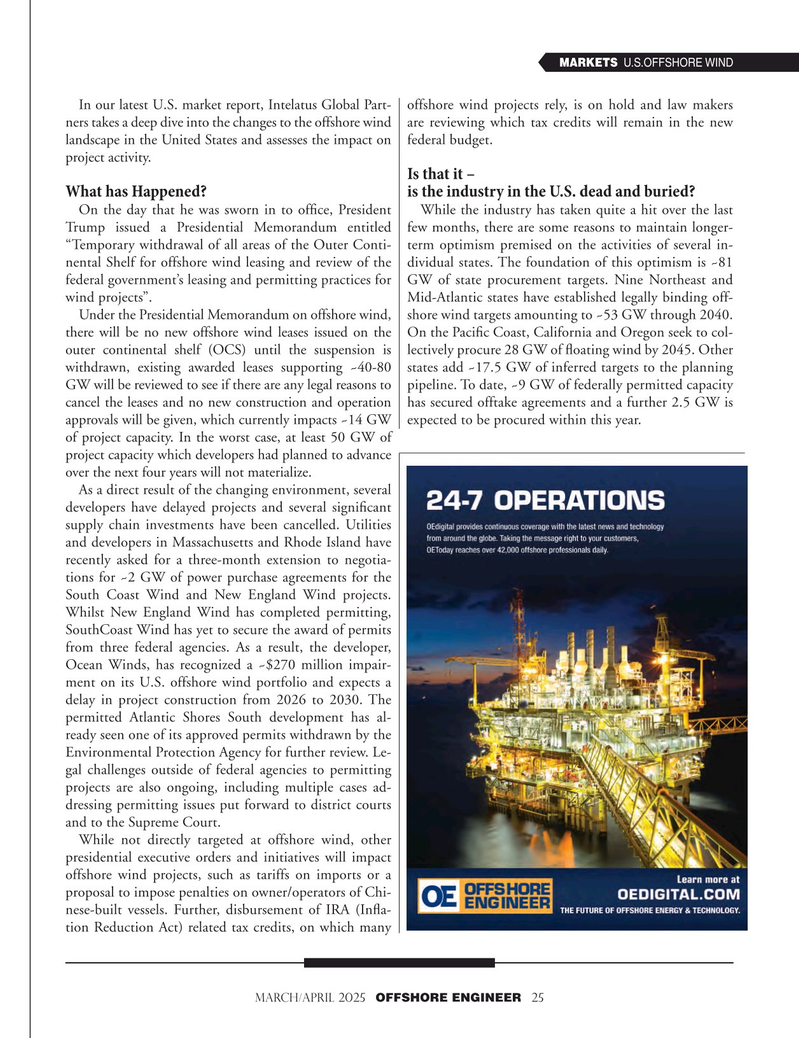
Page 25: of Offshore Engineer Magazine (Mar/Apr 2025)
Read this page in Pdf, Flash or Html5 edition of Mar/Apr 2025 Offshore Engineer Magazine
MARKETS U.S.OFFSHORE WIND
In our latest U.S. market report, Intelatus Global Part- offshore wind projects rely, is on hold and law makers ners takes a deep dive into the changes to the offshore wind are reviewing which tax credits will remain in the new landscape in the United States and assesses the impact on federal budget.
project activity.
Is that it –
What has Happened? is the industry in the U.S. dead and buried?
On the day that he was sworn in to offce, President While the industry has taken quite a hit over the last
Trump issued a Presidential Memorandum entitled few months, there are some reasons to maintain longer- “Temporary withdrawal of all areas of the Outer Conti- term optimism premised on the activities of several in- nental Shelf for offshore wind leasing and review of the dividual states. The foundation of this optimism is ~81 federal government’s leasing and permitting practices for GW of state procurement targets. Nine Northeast and wind projects”. Mid-Atlantic states have established legally binding off-
Under the Presidential Memorandum on offshore wind, shore wind targets amounting to ~53 GW through 2040. there will be no new offshore wind leases issued on the On the Pacifc Coast, California and Oregon seek to col- outer continental shelf (OCS) until the suspension is lectively procure 28 GW of foating wind by 2045. Other withdrawn, existing awarded leases supporting ~40-80 states add ~17.5 GW of inferred targets to the planning
GW will be reviewed to see if there are any legal reasons to pipeline. To date, ~9 GW of federally permitted capacity cancel the leases and no new construction and operation has secured offtake agreements and a further 2.5 GW is approvals will be given, which currently impacts ~14 GW expected to be procured within this year. of project capacity. In the worst case, at least 50 GW of project capacity which developers had planned to advance over the next four years will not materialize.
As a direct result of the changing environment, several developers have delayed projects and several signifcant supply chain investments have been cancelled. Utilities and developers in Massachusetts and Rhode Island have recently asked for a three-month extension to negotia- tions for ~2 GW of power purchase agreements for the
South Coast Wind and New England Wind projects.
Whilst New England Wind has completed permitting,
SouthCoast Wind has yet to secure the award of permits from three federal agencies. As a result, the developer,
Ocean Winds, has recognized a ~$270 million impair- ment on its U.S. offshore wind portfolio and expects a delay in project construction from 2026 to 2030. The permitted Atlantic Shores South development has al- ready seen one of its approved permits withdrawn by the
Environmental Protection Agency for further review. Le- gal challenges outside of federal agencies to permitting projects are also ongoing, including multiple cases ad- dressing permitting issues put forward to district courts and to the Supreme Court.
While not directly targeted at offshore wind, other presidential executive orders and initiatives will impact offshore wind projects, such as tariffs on imports or a proposal to impose penalties on owner/operators of Chi- nese-built vessels. Further, disbursement of IRA (Infa- tion Reduction Act) related tax credits, on which many march/april 2025 OFFSHORE ENGINEER 25

 24
24

 26
26